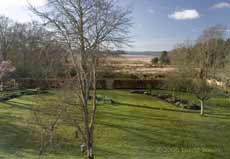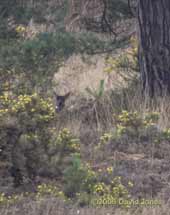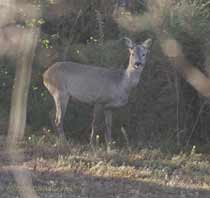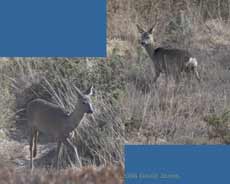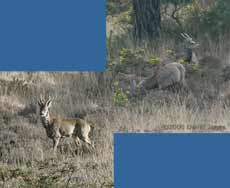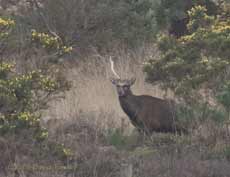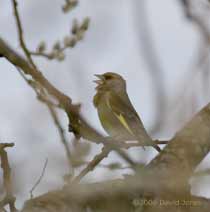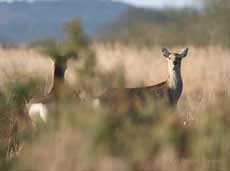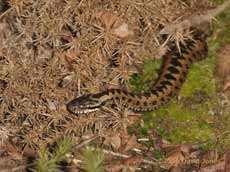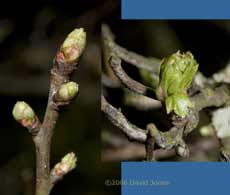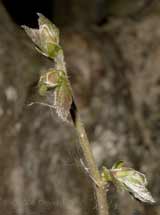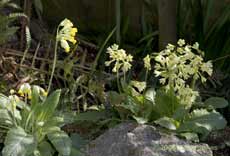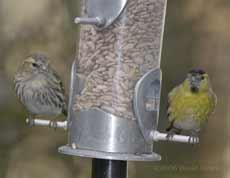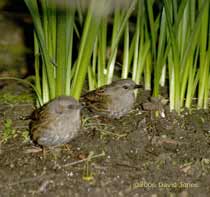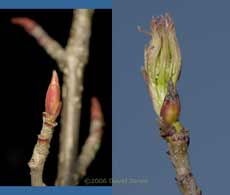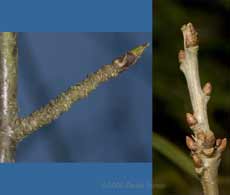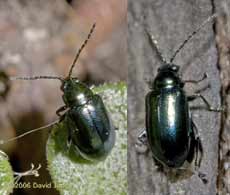Go to the last entry on this page .....Go to previous entry
30 March to 4 April - Our break by the backwaters of Poole Harbour Last year at this time we decided to have a short break down at Poole Harbour, staying in a B&B overlooking Lytchett Bay. We enjoyed that visit )although we had to cut the trip short because Sheila was unwell) so we headed that way again before the nesting season became too busy! This time we stayed at Lytchett Hard, a rather nice, and very friendly B&B run by David and Liz Collinson and their dog Cocoa.
Beyond the beech hedge there is an area of heathland which is an SSSI (Site of Special Scientific Interest), beyond which are reed beds around the margins of Lytchett Bay, and to the right is a small Pine woods.
The area is home for groups of Sika Deer. These Japanese Deer were introduced to an estate called Hyde House Park north of Wareham back in 1895 and inevitably escaped at various times between then and the Second World War. Now they are a problem because of the damage they can do, including to the reedbeds.
We didn't seen any deer last year, but this time I spotted a couple within minutes of moving into our room. They were a long way off, under the pine tree that you can see to the right of the view shown above. One can be seen easily, but you will need to look closely at the large image to see the one that is sitting down just to its right, and a bit nearer.
Over the next few days we saw them frequently in that spot, as well as grazing in other parts of the heath, up to three or four at a time.
This shot shows the white rump that stood out very clearly whenever they moved away.
Most of the time we only saw hinds, but occasionally males appeared.
This stag has cast one of its antlers, the remaining one showing up dramatically in the evening sunshine on the one occasion that I saw it. All of these pictures were taken through the window of our room and sometimes in poor light, so the sharpness isn't what it should be.
For most of our visit it was very windy so bird photography was a problem. However I'm including a few. First of all, I paid a couple of visits to Ham nature reserve, a small area sandwiched between a built up area and the waters of Poole Harbour. There were birds to be heard, but the windy conditions meant that they stayed largely out of sight
This Greenfinch was an exception as it sang loudly from the shelter of a small tree,
and this Dunnock paused just long enough before disappearing amongst the Gorse bushes, with their yellow flowers, that covered a lot of the area.
In one fairly sheltered spot a pair of Long-tailed Tits was moving from tree to tree, and while one kept up its almost constant high pitched call, the other was prising off lichens - I guess nest building had started. It's a slightly shaky image as the tree was in constant motion.
After breakfast on the morning of the 3rd, David (our host) took me out onto the heathland beyond the garden to show me where Adders regularly bask in the morning sunshine. As promised, they were there, three adders (although David assured me that he has seen up to six there). That morning we were a bit late so by the time I tried to take a couple of pictures they were active enough to disappear from view, so I went back out on the 4th, before we returned home. This time I went out at 7.30am to be ready when the sun rose over the trees. While I waited I was entertained by the occasional raucous call of the local Pheasant cock as he displayed to his mate. I couldn't see them as they were the other side of a gorse thicket, but after each call I could hear the low frequency rapid vibrations of feathers being displayed.
A second deer appeared and after a while they actually came a little bit closer, repeating the head movements and calls before retreating, at which point I took this very shaky picture from a half standing position. They continued to watch me for a few minutes more before bounding off towards the Pine woods, bouncing along as though their legs were springs. You can see a description of their behaviour, and hear the alarm call they made at By the time I turned back there were a couple of adders already out in the sunshine, although they were too far apart to photograph together. The nature of the vegetation meant that I could not get very close so I used my 300mm lens with an extension tube for the shots that follow.
First of all, a smaller one that conveniently coiled around, and sunbathed with its head held up.
This one exposed only part of itself.
This larger, paler individual seems to have flattened its body to offer the largest area possible to the sunshine. The paler slightly more grey colouring may indicate that this is a male.
Finally, I nearly missed this one. It wasn't sunbathing on the ground, but up in the vegetation to my left. Definitely the biggest Adder that I saw there, it measured well in excess of 2ft. Its size and reddish-brown colouring suggests that it was a fully grown female, based on what I have read since seeing them.
6 April - One problem with going away for a break is that when you (or at least, I) get back a holiday is needed - hence the slow restart of the diary! I've still to sort out the small number of pictures taken during the trip, and I'll be adding them to the beginning of this page as soon as I can. The last two days have seen brilliant sunshine, but with a cold, northerly wind and frosty mornings, with the birdbath frozen. In places sheltered from the wind it has got up to 14C in the garden this afternoon. It has been rather quiet in the garden today. The Sparrows and the Starlings are about, as are the Blackbirds. The Blue Tits appear occasionally, and of course the Great Tits. Yesterday there were Goldfinches and Siskins about but I have seen neither today. Similarly, I haven't seen a Robin today, a fact that I'm sure the Dunnock is aware of as it hunts through the undergrowth unmolested by its rival. As I've mentioned in the nestbox diary, yesterday I saw the female Blackbird gathering wet plant material from amongst the Irises in the small pond. She took them first to the Birch and then flew into the Ivy tree. While I have seen her on the ground a number of times today, I haven't seen her doing any more collecting.
By this afternoon one or two of the earliest leaves are starting to unfurl, although over most of the tree the first buds are a long way from this stage. The process is about two weeks later this year.
At the other end of the garden, next to the Ivy tree, the buds on the two small Cobnut saplings (Hazel - brought back from our Cornish campsite last year) have also burst. Next to them, the Elder leaves (not pictured) are quite well developed already.
By the side of the big pond the first flowers of the Snake's Head Fritillaries are getting closer to opening - last year the first flowers were open on 2 April.
On the far side of the pond the Oxlips are really well into their flowering. They are on the right in this picture, and you can compare their pale colouring with the deeper yellow of the Cowslips on the left.
7 April - A frost-free and dry morning, with increasing cloud cover with the temperature getting up to 10C by noon. It's been an interesting morning for the birds. I have seen Sparrows and Starlings taking away materials for their nests, with male Sparrows putting on impressive displays in the Hawthorn. Similarly, a pair of Dunnocks have been down on the ground together with the male displaying with great enthusiasm. At the top of the conifers a Wren spent a short time flitting from one high point to the next, singing loudly. While the Great Tit is having a busy morning in the nestbox, The Blue Tits are also nest building somewhere. Earlier I saw the female take moss for the side of the pond, and I have just seen her collect a beak full of fine dead grass bits. The female Blackbird must have completed her nest building and is only appearing to feed today. The male seems to spend some of his time in the lower branches of the Birch, watching over the part of the Ivy tree where the nest is hidden. He is very quiet compared with before we went away. I've now added a less than what I'd intended report on our trip to Poole Harbour. At some point I shall be looking at it again to see if I can improve it.
8 April - A gloriously sunny day with the temperature getting up to nearly 13C in the afternoon.
I've just planted most of them in a corner of the slope down from the West Wing, where the grass has failed badly. They should provide some welcome colour in that spot next Spring. I also bought some snowdrops that were also being sold off, and I'm planting these amongst the Narcissi as they will flower earlier. In the picture the tall bamboo plants (the ones I planted a couple of weeks back) hide the nestbox that is being used by the Great Tits.
At last, some more of the Lesser Cellandine plants are beginning to flower, but they are way behind in ground coverage as compared with last year.
This morning there were no Goldfinches, but we had two pairs of Siskins visit several times. The Blue Tits didn't seem to appreciate their presence and one of the Siskin males was chased around the Hawthorn for a couple of minutes - Why? Surely the Blue Tit doesn't regard the Siskin presence as a threat, does it?
The Dunnocks continue their courtship. This time I had my camera ready, but all the displaying, and I think, mating went on behind the modesty barrier of the Daffodil plants, and I was only able to grab this disappointing image when they emerged afterwards.
By this time last year we were seeing Ladybirds and various other insects about in the garden. So far this year I'm seeing precious little sign of them, apart from the occasional large, buff-tailed Bumble Bees that are investigating corners and holes around the garden. The Tit box microphone has picked up the buzzing of several flying up to the box entrance, and the cctv camera showed one in sight there. However I have yet to see one land there. When I checked it yesterday I think all the buds were intact, but at the end of this afternoon I checked the Rowan and spotted that not only had the buds started to burst, but one was already opening up to show what I think are developing flowers inside - and a few tiny greenfly on the outside! As the tree was only planted this time last year I shall have to wait at least another year before I can start comparing the dates of bud burst on this tree.
In the garden there are just two major plants left to reach this state, the Birch tree and the Oak tree (in a large pot!). The birch buds (on the left) look close to opening, but those on the Oak still appear tightly closed. However, it will be an interesting race. I expect the catkins on the Birch to open up first, and last year it was the second half of the month before the Oak and then the Birch produced their first leaves.
9 April - A bright start to the day, but there is more cloud this afternoon, and the forecast suggests that we could get heavy showers. There have been both Siskins and Goldfinches here today. The Dunnocks have been chasing each other around all morning, and I have heard and seen the Wren several times in the conifers. A female Chaffinch has been feeding, but we are still to see a male this Spring. While we were having breakfast I caught sight of a warbler at the other end of the garden. It was quite pale and greenish, but I didn't get a good look at its legs so I can't try to identify it. The binos are ready for its next visit. I have still to see a Robin since our return from Poole, which is a bit of a surprise, although I did hear one this morning so they are not far away. Also, we seem to have lost the Coal Tits, for the moment at least. It seems that I only have to comment on the failure of birds to turn up in the garden and hey-presto.... this afternoon the Robin made an appearance, heading for the mealworms as thought it hadn't been away, and a male Chaffinch paid a short visit to the sunflower feeder!
And this afternoon I found some insects to photograph. The first was spotted when its metallic blue body showed up in the sunlight. Only about 3mm in length, it is a flea beetle, possibly Phyllotreta nigripes or similar.
The second beetle I'm not able to suggest an identification for. It was on a plant not far from the flea beetle. It was slightly longer, nearer 4mm, and has that light rim to its elytra.
We did get some rain late in the afternoon, but not as much as the forecasts suggested.
10 April - A bright and sunny day, cold in the morning (2C at 8.30am) and up to 10C in the afternoon. There was actually snow in some places to the south-east of us to start the day, but we started frost-free. I forgot to mention that two nights ago there were two hedgehogs in the garden. I watched out for them last night but they didn't appear before I headed for bed. What I did find this morning was that one of our small log piles had been somewhat rearranged over night - have we had a fox visiting? As I write this at 5pm there is a Siskin at the niger feeder. The Siskins and the Goldfinches have been here numerous times during the day. The Goldfinches especially seem to be spending a lot of time at the bottom of the garden, on the Birch tree's higher branches and the Ivy tree. I wonder if they are looking to build their nest(s) in the conifers? I haven't caught sight of a Warbler today. Earlier, I tried to record one of them singing , but I'm afraid I was defeated by a combination of children on holiday, an ice-cream van's jingles and builders at work nearby! A few days ago I mentioned seeing Sparrows and Starlings picking up nesting materials. I've seen no further gathering taking place since then. Perhaps the drop in temperature has slowed things up again, or they've collected elsewhere. For the first time, I saw the Robin take away several mealworms - its first brood of the year must have hatched. Click on the images to see larger versions - |
|
